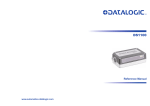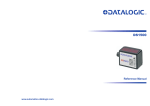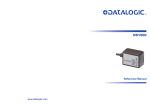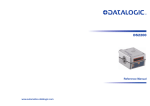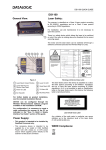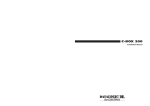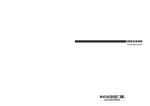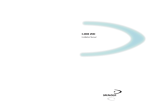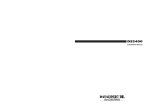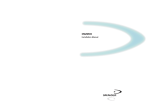Download Datalogic DS1100 SH2347 Installation manual
Transcript
Wichtiger Hinweis Im Handbuch unter Pkt. 1.2 – Description- ist vermerkt, das der DS1100 mit einer Betriebsspannung von 5V DC betrieben werden darf. Soll einen höhere Spannung, z.B. von einer SPS verwendet werden, dann ist ein DC/DC Konverter notwendig, der zwischen Anschlussbox und Scanner gesetzt wird. Darüber hinaus ist auch eine DS1100 Version mit dem Kürzel : SH 2347 hinter der Versions-Nummer verfügbar. Diese ist direkt zwischen 10 – 30 V DC z.B. an einer SPS betreibbar. Beachten Sie daher das Typenschild des Scanners vor dem Einbau. Ohne diese SH-Nummer wird der Scanner nach Anlegen einer Betriebsspannung > 5V DC zerstört !! Gerd Schroedter Tel: 0521-93270-55 E-Mail: [email protected] Seite 1 von 1 Datei: DS1100_warnung Stand: A Datum: 02/2004 DS1100 INSTALLATION MANUAL We Datalogic S.p.A. Via Candini, 2 40012 - Lippo di Calderara Bologna - Italy declare under our sole responsibility that the product(s) DS1100-XXXX, Laser Scanner and all its models to which this declaration relates is in conformity with the following standard(s) or other normative document(s) EN 55022, August 1994: LIMITS AND METHODS OF MEASUREMENTS OF RADIO DISTURBANCE CHARACTERISTICS OF INFORMATION TECHNOLOGY EQUIPMENT (ITE) EN 50082-2, March 1995: ELECTROMAGNETIC COMPATIBILITY. GENERIC IMMUNITY STANDARD. PART 2: INDUSTRIAL ENVIRONMENT Following the provision of the Directive(s): 89/336 CEE AND SUCCESSIVE AMENDMENTS, 92/31 CEE; 93/68 CEE Ruggero Cacioppo Lippo di Calderara, 12/07/1999 Quality Assurance Supervisor Product names mentioned herein are for identification purposes only and may be trademarks and or registered trademarks of their respective companies. Datalogic reserves the right to make modifications and improvements without prior notification. © - 1999 Datalogic S.p.A. 821000380 CONTENTS GUIDE TO INSTALLATION .............................................................. iv General View ......................................................................................v SAFETY PRECAUTIONS ................................................................. vi Laser Safety....................................................................................... vi 1 1.1 1.2 1.2.1 1.3 1.4 GENERAL FEATURES ...................................................................1.1 Introduction ......................................................................................1.1 Description.......................................................................................1.1 Indicators .........................................................................................1.2 Available Models..............................................................................1.2 Accessory ........................................................................................1.3 2 2.1 2.2 2.2.1 2.3 2.3.1 2.3.2 2.3.3 2.3.4 2.3.5 2.4 2.5 2.5.1 2.5.2 2.5.3 INSTALLATION ..............................................................................2.1 Package Contents ...........................................................................2.1 Mechanical Installation ....................................................................2.2 Reading Position..............................................................................2.3 Electrical Connections .....................................................................2.4 Power Supply...................................................................................2.4 Main Serial Interface - RS485 Half-Duplex......................................2.5 Auxiliary Interface - RS232 ..............................................................2.7 Inputs ...............................................................................................2.8 Outputs ............................................................................................2.9 Positioning .......................................................................................2.9 Typical Layouts ..............................................................................2.11 Point-to-Point .................................................................................2.11 RS485 Master/Slave......................................................................2.11 Multiplexer .....................................................................................2.13 3 3.1 3.2 3.3 3.3.1 3.4 READING FEATURES ....................................................................3.1 Step-Ladder Mode ...........................................................................3.1 Picket-Fence Mode..........................................................................3.2 Performance ....................................................................................3.3 Raster ..............................................................................................3.3 Reading Diagrams ...........................................................................3.4 4 4.1 MAINTENANCE ..............................................................................4.1 Cleaning...........................................................................................4.1 5 TECHNICAL FEATURES................................................................5.1 iii GUIDE TO INSTALLATION The following can be used as a checklist to verify all of the steps necessary for complete installation of the DS1100 scanner. 1) Read all information in the section "Safety Precautions” at the beginning of this manual. 2) Correctly position and mount the scanner for barcode reading according to the information in par. 2.2, 2.4 and 3.4. 3) Provide correct system cabling according to the signals necessary for your application (see all sub-paragraphs under 2.3). See also subparagraphs under 2.5 for reference. 4) Install the Configuration Disk. Upon successful completion of the installation, the readme.hlp file is opened, giving details about how to get started configuring your scanner. See also the Guide To Rapid Configuration link. Specific parameter details are available in the Help On Line. NOTE Fine tuning of the scanner position for barcode reading can be accomplished using the Test Mode as described in WinHost. The installation is now complete. iv DS1100 General View 1 2 3 4 5 6 7 8 1 Laser Beam Output Window 5 Ext Trig LED 2 TX Data LED 6 Power ON LED 3 Good Read LED 7 Laser Warning and Device Class Label 4 Laser ON LED 8 Mounting Holes Figure A v SAFETY PRECAUTIONS LASER SAFETY The following information is provided to comply with the rules imposed by international authorities and refers to the correct use of the DS1100 scanner. Standard Regulations This scanner utilizes a low-power laser diode. Although staring directly at the laser beam momentarily causes no known biological damage, avoid staring at the beam as one would with any very strong light source, such as the sun. Avoid that the laser beam hits the eye of an observer, even through reflective surfaces such as mirrors, etc. This product conforms to the applicable requirements of both IEC 825-1 and CDRH 21 CFR 1040 at the date of manufacture. The scanner is classified as a Class 2 laser product according to IEC 825-1 regulations and as a Class II laser product according to CDRH regulations. There is a safety device which allows the laser to be switched on only if the motor is rotating above the threshold for its correct scanning speed. The laser beam can be switched off through a software command (see also «Beam Shutter» in the WinHost Help On Line). WARNING Use of controls or adjustments or performance of procedures other than those specified herein may result in exposure to hazardous visible laser light. The laser light is visible to the human eye and is emitted from the window on the front of the scanner (Figure A, 1 ). vi The warning label indicating exposure to laser light and the device classification is applied onto the body of the scanner (Figure A, 7 ). Warning and device class label For installation, use and maintenance it is not necessary to open the scanner. The laser diode used in this device is classified as a class 3B laser product according to IEC 825-1 regulations and as a Class IIIb laser product according to CDRH regulations. As it is not possible to apply a classification label on the laser diode used in this device, the following label is reproduced here: LASER LIGHT AVOID EXPOSURE TO BEAM CLASS 3B LASER PRODUCT MAX. OUTPUT RADIATION 7 mW EMITTED WAVE LENGTH 630~680 nm TO IEC 825-1 (1993) Laser diode class label Any violation of the optic parts in particular can cause radiation up to the maximum level of the laser diode (7 mW at 630 to 680 nm). vii This page is intentionally left blank. viii DATALOGIC DS1100 1 GENERAL FEATURES 1.1 INTRODUCTION The DS1100 scanner with decoder offers the best cost-effective solution for demanding industrial applications. The DS1100 ultra compact dimensions, based on Datalogic's experience in miniaturised laser components, have been specifically designed to make the scanner's integration into automated equipment extremely easy. The Windows-based user-friendly WinHost utility program provided on diskette simplifies the scanner’s setup. The DS1100 can also be configured from a Host PC through the Host Mode procedure. 1.2 DESCRIPTION Some of the main features of DS1100 are listed below: • • • • • • • • • • • • • miniaturised dimensions, light weight. scanning speed: 350 scans/sec. raster version available. 2 serial communication interfaces: RS232 + RS485. reads all popular codes. supply voltage: 5 Vdc ( 4 to 30 Vdc with converter). test mode to verify the reading features and exact positioning of the scanner without the need for external tools. programmable in 4 different operating modes to suit the most various barcode reading system requirements. code verifier. programmable input and output signals. light source: visible laser diode; the light emitted has a wave length of 630 ∼ 680 nm. For laser safety precautions refer to the “Safety Precautions” section at the beginning of this manual. low power consumption. IP65 protection class of the enclosure; the reader is therefore suitable for General Features - 1.1 DS1100 DATALOGIC industrial environments where high protection against harsh external conditions is required. The laser beam output window is on the side of the scanner in DS1100XXX0 models and on the upper part of the scanner in DS1100-XXX1 models, (Figure A, ). A security system allows the laser to activate only once the motor has reached the correct rotational speed; consequently, the laser beam is generated after a slight delay from the power on of the scanner. 1.2.1 Indicators The five LEDs on the scanner indicate the following: POWER ON GOOD READ EXT TRIG TX DATA LASER ON (red) indicates the reader is connected to the power supply. (Figure A, ). (red) is used to signal the possibility of a successful barcode reading. (Figure A, ). (yellow) indicates external trigger activity. Refer to par. 2.3.4. (Figure A, ). (green). When blinking, it indicates data transmission. (Figure A, ). (green) indicates laser ON state. (Figure A, ). The screw holes on the body of the reader are for mechanical fixture (Figure A, ). 1.3 AVAILABLE MODELS The DS1100 scanner is available in versions that differ in regard to the following parameters: • Resolution. • Reading window position. • Linear or raster models. 1.2 - General Features DATALOGIC DS1100 The following models are therefore available: DS1100 - X X X X Optical Resolution Reading Window Position 1 = Standard Resolution 2 = High Resolution 0 = Direct 1 = 90° Serial Interface Linear/Raster 1 = RS232 + RS485 0 = Linear 1 = Raster The following tables display each version’s reading performance. mm (mils) 1XXX 2XXX 1XXX 2XXX scans/s 0.20 (8) 0.12 (5) 350 350 30 mm (1.2 in) - 220 mm (8.7 in) on 0.50 mm (20 mils) codes 10 mm (0.4 in) - 110 mm (4.3 in) on 0.30 mm (12 mils) codes See reading diagrams in par. 3.4 for further details. 1.4 ACCESSORY The following accessory is available on request: DC5-2200: DC converter 4-30 Vdc to 5 Vdc. General Features - 1.3 DS1100 DATALOGIC This page is intentionally left blank. 1.4 - General Features DATALOGIC DS1100 2 INSTALLATION 2.1 PACKAGE CONTENTS Verify that the DS1100 reader and all the parts supplied with the equipment are present and intact when opening the packaging; the list of parts includes: 1. 2. 3. 4. 5. DS1100 reader with cable Installation Manual DS1100 configuration program disk Bar code test chart (PCS = 0.9) Mounting kit: - bracket - screws 3 2 4 5 1 Figure 2.1 - DS1100 package contents Installation - 2.1 DS1100 DATALOGIC 2.2 MECHANICAL INSTALLATION DS1100 can be installed to operate in any position. There are three screw holes (M3 x 5) on the body of the reader for mounting. The diagram below gives all the information required for installation; refer to par. 2.4 for correct positioning of the scanner with respect to the code passage zone. DS1100 4 0.16 50 1.97 15.4 0.61 B 7.7 0.3 4 0.16 6 0.24 mm inch MOUNTING BRACKET Figure 2.2 - DS1100 overall dimensions 2.2 - Installation A 61 2.4 80 3.15 64.3 2.53 M3 n°3 22.5 0.89 DATALOGIC DS1100 2.2.1 Reading Position In DS1100-XXX1 models the laser beam is emitted from the output window with a 12° (± 2) skew angle. This allows installation with minimum overall dimensions. DS1100-XXX1 90° Reading Window Position Laser Beam 12° ± 2 Laser Beam DS1100-XXX0 Direct Reading Window Position ± 2° Figure 2.3 - Reading position Installation - 2.3 DS1100 DATALOGIC 2.3 ELECTRICAL CONNECTIONS The DS1100 cable is equipped with a 25-pin female D-sub connector for connection with the power supply and input/output signals: Figure 2.4 – 25-pin female D-sub connector 25-pin D-sub connector pinout Pin 9,13 25 1* 2, 21 3, 20 4 5 7 8 11 18 19 12, 22 23, 24 6, 10, 14, 15, 16, 17 Name VS GND CHASSIS TXAUX RXAUX RTX485RTX485+ SGND OUT1 + OUT2 + IN1 EXT TRIGGND N.U. NC Function Power supply input voltage + Power supply input voltage Chassis Ground TX RS232 Aux. Interface RX RS232 Aux. Interface RTX- RS485 Main Interface RTX+ RS485 Main Interface Signal Ground Output 1 + Output 2 + Input 1 External trigger Input/Output reference Not Used Not Connected * Pins 1 and 25 are connected together internally. 2.3.1 Power Supply The following pins of the DS1100 connector are used: DS1100 USER INTERFACE 13/9 V+ (5 Vdc) VS 25 GND GND CHASSIS 1 Figure 2.5 - Power supply connections The power must be 5 Vdc only. 2.4 - Installation DATALOGIC DS1100 2.3.2 Main Serial Interface - RS485 Half-Duplex The RS485 half-duplex interface (3 wires + shield) is used for polled communication protocols. It can be used for Multidrop connections in a master/slave layout or with a Datalogic Multiplexer, (see par. 2.5.2 and 2.5.3) exploiting a proprietary protocol based on polled mode called MUX32 protocol, where a master device polls slave devices to collect data. The connector pinout follows: Pin 5 4 7 Name RTX485+ RTX485 SGND Function RS485 + transmitted/received data RS485 - transmitted/received data Signal Ground DS1100 USER INTERFACE 5 RTX485 + 4 RTX485 - 7 SGND RS485 + RS485 - RS485 Ref Figure 2.6 - RS485 half-duplex connections For this interface type, the Multidrop Address must also be set via serial channel by the WinHost utility or by ESC sequences. Figure 2.7 shows an example of a multidrop configuration between a Multiplexer and DS1100 scanners. Installation - 2.5 DS1100 DATALOGIC 120 Ohm max 2 m DS1100 #x (up to 31) max 1200 m DS1100 #1 RTX485 + DS1100 #0 RTX485 SGND Three wires + shield RTX485 + RTX485 MULTIPLEXER RS485 REF SHIELD 120 Ohm Figure 2.7 - DS1100 Multidrop connection to a Multiplexer 2.6 - Installation DATALOGIC DS1100 2.3.3 Auxiliary Interface - RS232 The auxiliary serial interface is used exclusively for RS232 point-to-point connections. It is also used for configuring the DS1100. The parameters relative to the auxiliary interface (baud rate, data bits, etc.) can be defined using the Winhost utility program or "Host Mode Programming", installed from the diskette. The following pins of the 25-pin connector are used to connect the RS232 auxiliary interface: Pin Name Function 3, 20 2, 21 7 RXAUX TXAUX SGND Auxiliary input Auxiliary output Signal Ground DS1100 USER INTERFACE 3/20 RXAUX 2/21 TXAUX 7 SGND TXD RXD SGND Figure 2.8 - RS232 auxiliary interface connections Installation - 2.7 DS1100 DATALOGIC 2.3.4 Inputs The inputs available on the connector supplied with the scanner are indicated below: Pin Name Function 18 19 22 IN1 EXT TRIGGND Input 1 External trigger (input -) I/O Reference The EXT TRIG input is used to connect the external trigger which tells the scanner to scan for a code. The active state of this input is selected in software. Refer to the Winhost Help On Line. The yellow LED (Figure A, ) is on when EXT TRIG- is shorted to GND. This input is driven by an NPN type command. The connections are indicated in the following diagram: DS1100 +5V USER INTERFACE 13/9 VS V 47 K 19 EXT TRIG - 22 GND Signal Ground Figure 2.9 - External Trigger Input command The general purpose input IN1, in the Standard Application Program, can be used to store the code verifier (see “Store Verifier Hw” in the WinHost Help On Line). DS1100 +5V USER INTERFACE 13/9 VS V 47 K 18 IN1 - 22 GND Ground Figure 2.10 - IN1- Input command 2.8 - Installation DATALOGIC DS1100 An anti-disturbance hardware filter is implemented on the External Trigger input (about 1 millisecond delay). An additional 15 ms (typical) delay can be implemented through a dedicated software parameter (refer to WinHost Help On Line). 2.3.5 Outputs The following pins are present on the connector of the scanner: Pin 8 12 11 22 Name OUT1+ GND OUT2+ GND Function Output 1 + I/O Reference Output 2+ I/O Reference The meaning of the two outputs OUT1 and OUT2 can be defined by the user. Refer to the Winhost Help On Line. By default, OUT1 is the No Read signal, which activates when the code signalled by the external trigger is not decoded, and OUT2 is the Right output, which activates when the code is correctly decoded. DS1100 USER INTERFACE Vext 50 Vdc max., 50 mA max. 8/11 OUT 1 + / OUT 2 + 12/22 GND Ground Figure 2.11 - DS1100 Output connections These outputs are both level or pulse configurable. 2.4 POSITIONING The DS1100 scanner is able to decode moving barcode labels at a variety of angles, however significant angular distortion may degrade reading Installation - 2.9 DS1100 DATALOGIC performance. When mounting the DS1100 take into consideration these three ideal label position angles: Pitch 0°, Skew 15° to 30° and Tilt 0°. Follow the suggestions for the best orientation: The Pitch angle is represented by the value P in Figure 2.12. Position the reader in order to minimize the Pitch angle. Figure 2.12 - Pitch Angle The Skew angle is represented by the value S in Figure 2.13. Position the reader to assure about 15° for the Skew angle. This avoids the direct reflection of the laser light emitted by the DS1100. For the raster version, this angle refers to the most inclined or external raster line, so that all other raster lines assure more than 15° Skew. For the skew angle value with DS1100 90° versions, refer to par.2.2.1. Figure 2.13 - Skew angle The Tilt angle is represented by the value T in Figure 2.14. Position the reader in order to minimize the Tilt angle. Figure 2.14 - Tilt angle 2.10 - Installation DATALOGIC DS1100 2.5 TYPICAL LAYOUTS 2.5.1 Point-to-Point In this layout data is transmitted to the Host on the RS232 Auxiliary serial interface. The Local Echo communication mode must be enabled (default) See the Winhost Help On Line. When On-Line Operating mode is used, the scanner is activated by an External Trigger (photoelectric sensor) when the object enters its reading zone. Figure 2.15 – Point to Point Layout 2.5.2 RS485 Master/Slave The RS485 master/slave connection is used to collect data from several scanners to build a multi-point or a multi-sided reading system; there can be one master and up to 5 slaves connected together. The Slave scanners are connected together using the RS485 half-duplex main serial interface. Every slave scanner must have a multidrop address in the range 0-4. The master scanner is also connected to the Host on the RS232 auxiliary serial interface. For details, see the Guide To Rapid Configuration in the WinHost Help On Line. Installation - 2.11 DS1100 DATALOGIC The External Trigger signal is unique to the system; there is a single reading phase and a single message from the master scanner to the Host computer. The main and auxiliary ports are connected as shown in the following figure. Figure 2.16 – RS485 Master/slave layout NOTE The auxiliary serial port of the slave scanners can be used in Local Echo communication mode to control any single scanner (visualize collected data) or to configure it using the WinHost utility or Host Mode programming procedure. The termination resistors of the RS485 bus must not be installed. 2.12 - Installation DATALOGIC DS1100 2.5.3 Multiplexer Each scanner is connected to a Multiplexer (for example MX4000) with the RS485 half-duplex main interface. 31 1 0 MX4000 Figure 2.17 - Multiplexer layout The auxiliary serial interface can be used in Local Echo mode to control any single scanner (visualize collected data) or to configure it using the WinHost utility or Host Mode programming procedure. When On-Line Operating mode is used, the scanner is activated by an External Trigger (photoelectric sensor) when the object enters its reading zone. Installation - 2.13 DS1100 DATALOGIC This page is intentionally left blank. 2.14 - Installation DATALOGIC DS1100 3 READING FEATURES The number of scans performed on the code by the DS1100 and therefore the decoding capability is influenced by the following parameters: • number of scans per second • code motion speed • label dimensions • scan direction in respect to code motion Typically, 5 scans should be allowed during the code passage to ensure a successful read. 3.1 STEP-LADDER MODE Code motion direction at LS speed Laser beam Figure 3.1 - "Step-ladder" scanning mode If scanning is perpendicular to the code motion direction (Figure 3.1 - "stepladder" mode), the number of effective scans performed by the reader is given by the following formula: SN = [(LH/LS) * SS] - 2 These symbols signify: SN = number of effective scans LH = label height (in mm) LS = label movement speed (in mm/s) SS = number of scans per second For example, the DS1100 (350 scans/sec.) for a 25 mm high code moving at Reading Features - 3.1 DS1100 DATALOGIC 500 mm/s performs: [(25/500) * 350] - 2 = 15 effective scans. 3.2 PICKET-FENCE MODE Code motion direction at LS speed Laser beam Figure 3.2 - "Picket-fence" scanning mode If scanning is parallel to the code motion, (Figure 3.2 - "picket-fence" mode), the number of effective scans is given by: SN = [((FW-LW)/LS) * SS] -2 These symbols signify: SN FW LW LS SS = = = = = number of effective scans reading field width (in mm) label width (in mm) label movement speed (in mm/s) scans per second For example, for a 50 mm wide code moving in a point where the reading field is 180 mm wide at a 1300 mm/s speed, the DS1100 (350 scans per sec.), performs: [((180-50)/1300) * 350] - 2 = 33 scans 3.2 - Reading Features DATALOGIC DS1100 3.3 PERFORMANCE The DS1100 scanner is available in different versions according to the reading performance. mm (mils) 1XXX 2XXX 1XXX 2XXX scans/s 0.20 (8) 0.12 (5) 350 350 30 mm (1.2 in) - 220 mm (8.7 in) on 0.50 mm (20 mils) codes 10 mm (0.4 in) - 110 mm (4.3 in) on 0.30 mm (12 mils) codes Refer to the diagrams given in par. 3.4 for further details on the reading features. These diagrams are taken on various resolution sample codes at a 25 °C ambient temperature, depending on the conditions listed under each diagram. 3.3.1 Raster Raster versions are available. If standard devices do not satisfy specific requirements, contact your nearest Datalogic distributor, supplying code samples, to obtain complete information on the reading possibilities. The max. capture of raster versions is 15 mm (0.6 in) at 220 mm (8.7 in). Reading Features - 3.3 DS1100 DATALOGIC 3.4 READING DIAGRAMS The following diagrams show the reading distance for barcodes with different densities. DS1100-1XXX Standard Resolution 0 20 40 60 80 100 120 140 160 180 200 220 mm 100 80 60 40 20 0.20 mm (8 mils ) 0 0.30 mm (12 mils) 20 40 60 80 100 mm NOTE (0,0) is the center of the laser beam output window. CONDITIONS: Code PCS "Pitch" angle "Skew" angle "Tilt" angle = = = = = Interleaved 2/5 or Code 39 0.90 0° 15° 0° 3.4 - Reading Features 0.50 mm, (20 mils) DATALOGIC DS1100 DS1100-2XXX High Resolution 0 10 20 30 40 50 60 70 80 90 100 110 mm 60 50 40 30 0.20 mm (8 mils ) 20 0.30mm (12 mils) 10 0.12 mm (5 mils ) 0 10 20 30 40 50 60 mm NOTE (0,0) is the center of the laser beam output window. CONDITIONS: Code PCS "Pitch" angle "Skew" angle "Tilt" angle = = = = = Interleaved 2/5 or Code 39 0.90 0° 15° 0° Reading Features - 3.5 DS1100 DATALOGIC This page is intentionally left blank. 3.6 - Reading Features DATALOGIC DS1100 4 MAINTENANCE 4.1 CLEANING Clean the windows periodically for continued correct operation of the reader. Dust, dirt, etc. on the windows may alter the reading performance. Repeat the operation frequently in particularly dirty environments. Use soft material and alcohol to clean the windows and avoid any abrasive substances. WARNING Clean the window of the DS1100 when the scanner is turned off or, at least, when the laser beam is deactivated. Maintenance - 4.1 DS1100 DATALOGIC This page is intentionally left blank. 4.2 - Maintenance DATALOGIC DS1100 5 TECHNICAL FEATURES DS1100-1XXX DS1100-2XXX ELECTRICAL FEATURES Maximum input voltage Power consumption max. 5 Vdc ± 5% 1.5 W INPUTS / OUTPUTS Serial interfaces: Main Auxiliary Baud Rates Control Inputs Outputs VCE max. Collector current max. VCE saturation Power dissipation max. RS485 half-duplex RS232 150 to 115200 baud External Trigger; Aux. Input User-defined OUT1 and OUT2 50 Vdc 50 mA continuous 0.3V at 10 mA max. 200 mW at 40 °C (Ambient temp.) OPTICAL FEATURES Light source Wave length (Note 1) Safety class Semiconductor laser diode 630 ∼ 680 nm Class 2 - IEC 825-1; Class II - CDRH READING FEATURES (Note 2) Scan rate Aperture angle Max. Reading distance Maximum resolution 350 scans/sec 70° 220 mm, (8.7 in) 110 mm (4.3 in) 0.20 mm (8 mils) 0.12 mm (5 mils) USER INTERFACE LED indicators Power ON, Good Read, Ext Trig, TX Data, Laser ON Technical Features - 5.1 DS1100 DATALOGIC SOFTWARE FEATURES READABLE CODE SYMBOLOGIES • EAN/UPC (including Add-on 2 and Add-on 5) • Code 93 • 2/5 Interleaved • Code 128 • Code 39 (Standard and Full ASCII) • EAN 128 • Codabar • Pharmacode Other symbologies available on request. up to six different codes during one reading phase CODE SELECTION DECODING SAFETY can enable multiple good reads of same code HEADERS AND TERMINATORS up to four headers and four terminators OPERATING MODES On-Line, Automatic, Serial-On-Line, Test CONFIGURATION MODES • through menus using WinHost utility • receiving commands from one of the serial ports (HOST MODE) Non-volatile internal EEPROM PARAMETER STORAGE ENVIRONMENTAL FEATURES Operating temperature (Note 3) 0 to 45 °C (32 to 113 °F) Storage temperature -20 to 70 °C (-4 to 158 °F) 90% non condensing IEC 68-2-6 test FC 1.5 mm; 10 to 55 Hz; 2 hours on each axis IEC 68-2-27 test EA 30G; 11 ms; 3 shocks on each axis IP65 Humidity max. Vibration resistance Shock resistance Protection class PHYSICAL FEATURES Mechanical dimensions Weight without cable 80 x 50 x 22 mm (3.15 x 1.97 x 0.89 in.) <100 g. (<3.53 oz.) Note 1: The features given are typical at a 25 °C ambient temperature (if not otherwise indicated). Note 2: Further details given in par. 3.3 and 3.4. Note 3: If the reader is used for a long period of time in high temperature environments (over 40 °C), use of the Beam Shutter is advised (see the Winhost configuration program). 5.2 - Technical Features







































